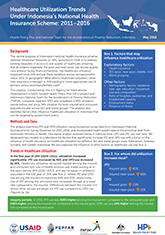Healthcare Utilization Trends Under Indonesia’s National Health Insurance Scheme: 2011–2016
The central purpose of Indonesia’s national health insurance scheme Jaminan Kesehatan Nasional, or JKN, launched in 2014, is to address existing inequities in access to and quality of healthcare, ensuring
that all citizens, especially the poor and near-poor, can access quality care without facing financial hardship.
Has healthcare utilization improved since JKN and are there variations across socioeconomic
status (SES) or geography? What affects healthcare utilization, other than insurance coverage? Is JKN leading to more appropriate use of primary versus secondary/tertiary care?
This analysis, conducted by the U.S. Agency for International Development (USAID)-funded Health Policy Plus (HP+) project and Indonesia’s National Team for the Acceleration of Poverty Reduction
(TNP2K), compares inpatient (IPD) and outpatient (OPD) utilization trends before and since JKN initiation for both insured and uninsured populations and across SES and island groups. The analysis also identifies factors that influence healthcare utilization in Indonesia that can be targeted by government policy.
